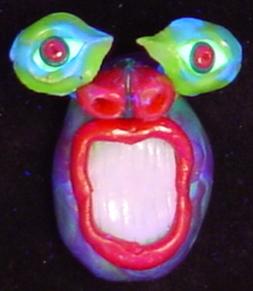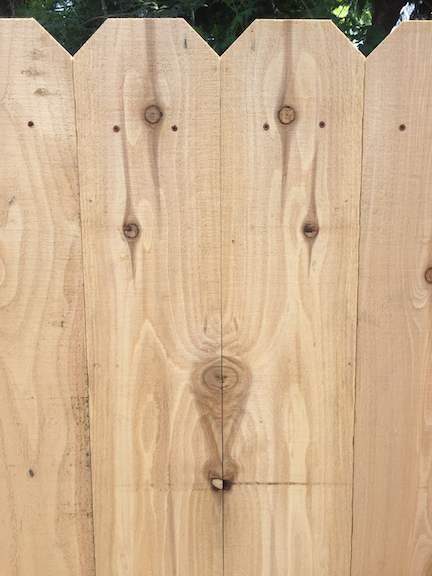October 2020
The Beginning of CapturedChaosArt
13/10/20 09:04
I’ve been enjoying acrylic pour painting during the pandemic. The materials are not very expensive and there are lots of great videos online about how to do it. It’s very popular and it isn’t very hard to get interesting results.
I soon began to notice parallels between it and other media I’ve explored, such as polymer clay and wood. With polymer clay I enjoyed combining solid colors without blending them. I’d prepare a ball or rectangular solid and then cut it in half. The inside was beautiful and chaotic. When I mated the left and right sides I would get a “book match”, symmetry along a vertical line. The almost mirror image turned the chaos into something much more beautiful”. This was the first time I really sat down and thought about “Beautiful Chaos”, which is what I called incorporating chaos into my art as a primary influencer of the outcome.


I really got into making art with polymer clay around 2000. In 2001 I produced the 3ddoodle.com web site, which featured art made by myself and Michael Marx, who taught me how to make things with polymer clay. It is hard to sell anything made with polymer clay because it is after all plastic and most people don’t place much value on plastic things, or at least, that is what Michael and I both believed. Michael transitioned to precious metal clay, which is powdered silver or gold mixed with powdered paper and water. It feels and works like clay but when he takes it out of a kiln the paper and water have disappeared leaving behind almost completely pure gold or silver. His jewelry is amazing and you can see and buy it at his website, unsaneart.com.
I owe a lot to Michael Marx, who helped me understand how to be an artist and how to make things with polymer clay, especially monsters:

The thing about polymer clay that I liked most was how seemingly ordered steps like folding and bending and rolling up into a ball led to vastly different and very beautiful outcomes. I worked on a taxonomy of folds to try to understand what was happening. Naming a thing doesn’t really equate to understanding a thing, but I believe it is a step in the right direction.
In woodworking I often look for opportunities to use a book match to make a project look nicer.

The cedar fence boards above were cut apart from each other in a lumber mill. Before that point the two were one piece. When the saw went through that piece at the lumber mill it revealed a grain and knot pattern that was nearly identical in the two pieces produced by that cut. These two boards remained next to each other from the lumber mill all the way to my work site where I built a fence with entirely book matched pairs of fence boards, like this pair.
The two sides aren’t identical if you look closely. That’s because the different components of wood that comprise the patterns are not going through the wood exactly perpendicular to the board. The knots go through at an angle in three dimensions. And the different growth rings are all circular in one dimension as they dive through the board, but much less constrained along the length of the board. The curves for every tree ring are unique, and book matching two sets of curves becomes natural art - beauty from chaos.
In the 20 years that transpired between when I was experimenting with polymer clay and when I made this book matched fence I encountered beauty in chaos almost anywhere I cared to look closely enough:
I found in social contexts. For example, I used to run a Burning Man camp called Nose Fish. I learned that if people expect you to provide food the best you can accomplish is to meet their expectation, and the worst you can do is completely let them down for something they cannot do without. That is quite a range, but meeting expectations is all the way on one end of that range.
An alternative is to ask everyone to be self-sufficient for food and maybe bring a little extra to share, something completely different and less predictable happens. What I observed was that the very worst that would happen to anyone was that their own expectations were met. That was the worst case scenario, because they themselves brought enough to meet their own needs. On the other end of that scale was everyone spontaneously working together at meal times to put together group meals we made together. It can be a natural bonding and sharing experience that brings together the camp. It can be all that a shared meal can ever be to people who work together.
Again, these are the two scales:
Scale 1: From “Meets expectations” through “utter disappointment for something very important”
Scale 2: From “Meets expectations” through “the epitome of how food brings people together”
The big difference is control vs. chaos. Or, more specifically, whether to exert control or whether to work toward beautiful chaos. Scale 1 goes along with retaining control. Scale 2 gives up central control for individual control. It means you might end up with eggs but no butter. Except that it turns out that when there isn’t a plan for providing some butter, everyone who brought eggs also brought butter, so there’s more than enough butter. Even for other purposes. And so on, like the layers of a pearl. For people to provide for their own needs they end up filling in all the small components that would otherwise have to be managed, like salt, oil.
People providing for their own needs also guarantees that people with dietary needs have them met to their own satisfaction without having even to explain them to anyone. Or justify them.
I saw beautiful chaos succeed easily where attempts at more centralized planning utterly failed. It isn’t that a centralized plan can’t facilitate beautiful chaos. It can. It can make sure there are things like facilities to store people’s food, or stoves to prepare it. There are plenty of common needs.
When I watched videos about pour painting I could immediately see how this was a means to invite chaos to the creative table. I was fascinated an tried it with a friend who had purchased a small kit. Then I started buying paint and canvases from Blick art supply and exploring whenever I could. I watched lots of videos - a lot of people do this kind of art and there are some really good videos out there to enjoy and learn from.
I loved making paintings and before I knew it I had about 75 paintings and maybe half of them were special somehow. Chaos as a creative partner is bursty, at best. Later I realized that if I don’t like the way a painting looks yet, I don’t have to be done with it. Some paintings are beyond redemption. I try things that don’t work. But, sometimes I try things that do work and suddenly I have a go-to technique to help a painting be better, or even great occasionally.
Because we are in a pandemic most people I know had never seen any of my paintings, so I posted them to social media and the response was really positive. So, I posted more photos of my art and people asked if they were for sale.
I found that capturedchaosart.com was an unowned domain name and also an unowned Etsy store name. Yoink!
So now I am beginning what I hope is a long exploration to find out how much beauty I can create with chaos as a constructive partner.
Chaos isn’t shy and it’s infinitely patient. That’s good, because I have a lot of art to make...
I soon began to notice parallels between it and other media I’ve explored, such as polymer clay and wood. With polymer clay I enjoyed combining solid colors without blending them. I’d prepare a ball or rectangular solid and then cut it in half. The inside was beautiful and chaotic. When I mated the left and right sides I would get a “book match”, symmetry along a vertical line. The almost mirror image turned the chaos into something much more beautiful”. This was the first time I really sat down and thought about “Beautiful Chaos”, which is what I called incorporating chaos into my art as a primary influencer of the outcome.


I really got into making art with polymer clay around 2000. In 2001 I produced the 3ddoodle.com web site, which featured art made by myself and Michael Marx, who taught me how to make things with polymer clay. It is hard to sell anything made with polymer clay because it is after all plastic and most people don’t place much value on plastic things, or at least, that is what Michael and I both believed. Michael transitioned to precious metal clay, which is powdered silver or gold mixed with powdered paper and water. It feels and works like clay but when he takes it out of a kiln the paper and water have disappeared leaving behind almost completely pure gold or silver. His jewelry is amazing and you can see and buy it at his website, unsaneart.com.
I owe a lot to Michael Marx, who helped me understand how to be an artist and how to make things with polymer clay, especially monsters:

The thing about polymer clay that I liked most was how seemingly ordered steps like folding and bending and rolling up into a ball led to vastly different and very beautiful outcomes. I worked on a taxonomy of folds to try to understand what was happening. Naming a thing doesn’t really equate to understanding a thing, but I believe it is a step in the right direction.
In woodworking I often look for opportunities to use a book match to make a project look nicer.

The cedar fence boards above were cut apart from each other in a lumber mill. Before that point the two were one piece. When the saw went through that piece at the lumber mill it revealed a grain and knot pattern that was nearly identical in the two pieces produced by that cut. These two boards remained next to each other from the lumber mill all the way to my work site where I built a fence with entirely book matched pairs of fence boards, like this pair.
The two sides aren’t identical if you look closely. That’s because the different components of wood that comprise the patterns are not going through the wood exactly perpendicular to the board. The knots go through at an angle in three dimensions. And the different growth rings are all circular in one dimension as they dive through the board, but much less constrained along the length of the board. The curves for every tree ring are unique, and book matching two sets of curves becomes natural art - beauty from chaos.
In the 20 years that transpired between when I was experimenting with polymer clay and when I made this book matched fence I encountered beauty in chaos almost anywhere I cared to look closely enough:
- In the swirling colors of a soap bubble or oil spill
- In the book match of any non-homogeneous material when it is cut
- In the way sand settles under waves
- In the way mica flakes settle and twinkle on the edge of a mountain river
- In the shimmering colors of an abalone shell, or a labradorite stone
I found in social contexts. For example, I used to run a Burning Man camp called Nose Fish. I learned that if people expect you to provide food the best you can accomplish is to meet their expectation, and the worst you can do is completely let them down for something they cannot do without. That is quite a range, but meeting expectations is all the way on one end of that range.
An alternative is to ask everyone to be self-sufficient for food and maybe bring a little extra to share, something completely different and less predictable happens. What I observed was that the very worst that would happen to anyone was that their own expectations were met. That was the worst case scenario, because they themselves brought enough to meet their own needs. On the other end of that scale was everyone spontaneously working together at meal times to put together group meals we made together. It can be a natural bonding and sharing experience that brings together the camp. It can be all that a shared meal can ever be to people who work together.
Again, these are the two scales:
Scale 1: From “Meets expectations” through “utter disappointment for something very important”
Scale 2: From “Meets expectations” through “the epitome of how food brings people together”
The big difference is control vs. chaos. Or, more specifically, whether to exert control or whether to work toward beautiful chaos. Scale 1 goes along with retaining control. Scale 2 gives up central control for individual control. It means you might end up with eggs but no butter. Except that it turns out that when there isn’t a plan for providing some butter, everyone who brought eggs also brought butter, so there’s more than enough butter. Even for other purposes. And so on, like the layers of a pearl. For people to provide for their own needs they end up filling in all the small components that would otherwise have to be managed, like salt, oil.
People providing for their own needs also guarantees that people with dietary needs have them met to their own satisfaction without having even to explain them to anyone. Or justify them.
I saw beautiful chaos succeed easily where attempts at more centralized planning utterly failed. It isn’t that a centralized plan can’t facilitate beautiful chaos. It can. It can make sure there are things like facilities to store people’s food, or stoves to prepare it. There are plenty of common needs.
When I watched videos about pour painting I could immediately see how this was a means to invite chaos to the creative table. I was fascinated an tried it with a friend who had purchased a small kit. Then I started buying paint and canvases from Blick art supply and exploring whenever I could. I watched lots of videos - a lot of people do this kind of art and there are some really good videos out there to enjoy and learn from.
I loved making paintings and before I knew it I had about 75 paintings and maybe half of them were special somehow. Chaos as a creative partner is bursty, at best. Later I realized that if I don’t like the way a painting looks yet, I don’t have to be done with it. Some paintings are beyond redemption. I try things that don’t work. But, sometimes I try things that do work and suddenly I have a go-to technique to help a painting be better, or even great occasionally.
Because we are in a pandemic most people I know had never seen any of my paintings, so I posted them to social media and the response was really positive. So, I posted more photos of my art and people asked if they were for sale.
I found that capturedchaosart.com was an unowned domain name and also an unowned Etsy store name. Yoink!
So now I am beginning what I hope is a long exploration to find out how much beauty I can create with chaos as a constructive partner.
Chaos isn’t shy and it’s infinitely patient. That’s good, because I have a lot of art to make...
